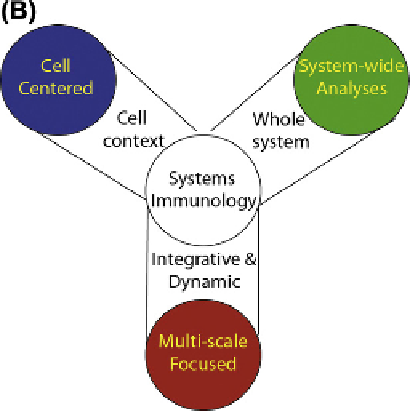Biology Reference
In-Depth Information
discussion in this chapter. In fact, a systems approach has
deep roots in immunology itself, as 'systems-wide' ques-
tions and reasoning have always occupied an important
place in some of the earliest work in the field; however, in
more recent decades difficulties encountered in the more
theoretical work has forced a retreat to more reductionist
approaches.
We define systems immunology as a new start at
'putting the pieces together' with the goal of directly
studying how immunity functions as a system. That is, how
changes in one compartment of the immune system affect
other parts, and how together these components orchestrate
a response that is greater than the sum of its parts. The
experimental approach taken is quantitative and requires
extensive computation to incorporate the results into
increasingly comprehensive and accurate models. We will
distinguish measurements on an 'omics' scale (referred to
here as 'high-bandwidth biology') that often aims to detect
biomarkers, from systems immunology, which focuses
more on interactions than on individual components,
although these two directions of research often overlap. In
other biological research areas, such as cancer and genetics,
systems biology approaches have been around for a decade
or more. In immunology, however, these approaches are
much more recent owing to the high system complexity and
its diffuse nature, and for some immune components, such
as cell types, it is only very recent developments that enable
us to enumerate their many different subsets.
In systems immunology there been no single starting
point, nor a single research focus. Rather, researchers are
converging from a variety of fields: from immunologists
and clinicians who measure the immune system at an
'omics' scale to systems biologists, computer scientists and
mathematical modelers who are challenged by the 'next
frontier' and drawn by the clinical relevance of the field.
The former bring immune know-how and measurement
techniques, the latter bring methodology and approaches
originally developed for other domains and now being
adapted to systems immunology. Together these researchers
are discovering a remarkable level of complexity, such
as additional specialized cell types
[1,2]
, non-uniform
sampling of variable diverse joining (VDJ) recombination
(see later;
FIGURE 25.1
(Continued)
development of vaccines for infectious diseases such as
smallpox, measles etc., has had an enormous impact over
the last century, and remains the most efficacious medical
intervention to date in terms of lives saved. However, many
challenges remain to be resolved, such as developing
effective vaccines for HIV, malaria and tuberculosis, among
others, and while there are promising developments we
have still a long way to go in using the immune system to
combat cancer and many other diseases in which it is
involved. Lastly, there are dozens of syndromes in which
the immune system attacks the body's own tissues or
organs, such as type 1 diabetes, rheumatoid arthritis,
multiple sclerosis and many others for which we have an
inadequate understanding and thus far no ability to cure.
As in other fields, a reductionist approach has been the
predominant strategy in immunology research for many
years. Research is often focused on understanding the role
of a single cell type or compartment (e.g., B cells).
Although fruitful, such studies often disregard the cooper-
ativity and cross-talk between the different components of
the immune system. Similarly, traditional studies of indi-
vidual genes have often been difficult owing to the large
number of different cell types in which each immune gene
is expressed, often with different functions. The effect of
cytokines on cells often differs according to the cell type
and the stage at which the interaction occurs. Immunolo-
gists in each such subfield have made huge advances
toward understanding particular segments of the immune
system; however, assembling the whole puzzle from its
pieces is both necessary and now more possible owing to
the fact that many key parts and principles of the immune
system have become well understood and can be measured
simultaneously. Systems immunology has recently
emerged as a distinct discipline and is the topic of
[3,4]
), and complex temporal
regulatory
programs for intercellular communication
[5,6]
.
Here we review the development of this nascent field
and the initial findings and concepts that have emerged.
We structure our discussion into three main sections: cell-
focused, system-focused, and multi-scale focused. This
delineation emphasizes both the principal differences in
the way researchers are probing the immune system as
well as the insights obtained (
Figure 25.1
B). In the first,
cell-focused section, the emphasis is on understanding
intracellular components and mechanisms in detail, which
does not consider interactions with the rest of the immune





